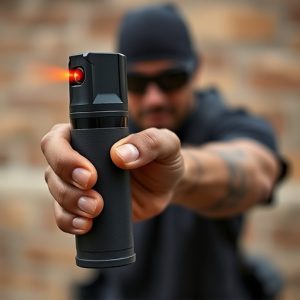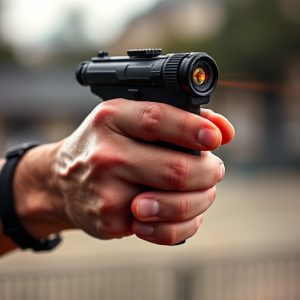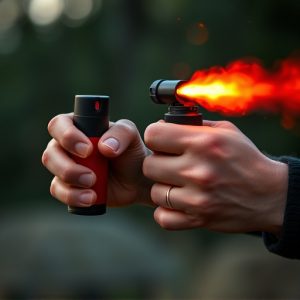Low Light Pepper Spray Tactics: Understanding O.C. Spray for Self-Defense
Low light pepper spray tactics are essential for personal safety in challenging, dimly lit environme…….
Low light pepper spray tactics are essential for personal safety in challenging, dimly lit environments. Oleoresin capsicum (OC) sprays, or pepper spray, temporarily disable attackers by targeting their eyes and respiratory system. Effective use requires understanding OC concentration, spray range, accuracy, swift deployment, and proper training techniques, including de-escalation methods and accurate threat assessment. Regular practice in controlled environments builds muscle memory for strategic deployment as a last resort. Staying informed about local regulations and different spray types enhances personal safety while avoiding legal issues.
“Discover the power of oleoresin capsicum (O.C.) spray as a versatile self-defense tool, especially in low light conditions. This article explores the composition and effectiveness of O.C. spray, offering valuable insights into its tactical applications during dim lighting. We’ll guide you through safety measures, training considerations, and legal implications, empowering you to make informed decisions regarding this game-changing low light pepper spray tactic for personal protection.”
- Understanding Oleoresin Capsicum Spray: Composition and Effectiveness
- Low Light Conditions: Challenges and Opportunities for Pepper Spray
- Tactical Applications: How to Utilize O.C. Spray in Dim Lighting
- Safety and Training Considerations for Effective Deployment
- Legal Implications and Best Practices for Self-Defense with Pepper Spray
Understanding Oleoresin Capsicum Spray: Composition and Effectiveness
Oleoresin capsicum spray, often referred to as pepper spray, is a non-lethal self-defense tool designed to temporarily incapacitate an attacker. Its active ingredient is oleoresin capsicum (OC), derived from red chili peppers. OC stimulates nerve endings in the eyes and respiratory system, causing intense pain, temporary blindness, and difficulty breathing. This disruption can enable the user to escape or subdue their assailant until help arrives.
In low light pepper spray tactics, understanding the composition of oleoresin capsicum spray is crucial. The concentration of OC varies among brands, with higher concentrations offering greater effectiveness in darker environments where visibility is limited. The spray’s range and accuracy also play a significant role; shorter ranges may require closer proximity to the attacker, while improved accuracy ensures that the spray reaches its target more reliably. Effective low light pepper spray tactics involve proper training, ensuring the spray is within reach, and understanding how to deploy it swiftly and accurately under challenging conditions.
Low Light Conditions: Challenges and Opportunities for Pepper Spray
In low light conditions, traditional pepper spray tactics may face challenges due to reduced visibility. However, this also presents an opportunity for strategic deployment of low light pepper spray solutions. Specialized formulations designed for dimly lit environments offer enhanced efficacy and accuracy by taking advantage of heat-seeking capabilities and specialized delivery mechanisms. These innovative products can pinpoint targets more effectively, ensuring the user’s safety while neutralizing threats in night-time encounters or situations with limited illumination.
Understanding how low light conditions impact pepper spray performance allows users to choose the right tools for optimal effectiveness. This includes considering factors like range, visibility of the spray pattern, and duration of effectiveness. By adopting low light pepper spray tactics, individuals can better protect themselves in challenging scenarios where traditional methods might be less reliable.
Tactical Applications: How to Utilize O.C. Spray in Dim Lighting
In tactical situations, particularly those involving low light or night operations, the effectiveness of oleoresin capsicum (O.C.) spray as a defense tool is significantly enhanced. O.C. spray, known for its powerful pepper spray components, can create a temporary yet potent disability in dim lighting by targeting the eyes and respiratory system of an aggressor. The visibility-reducing effects of low light conditions allow users to apply the spray at close range, ensuring maximum impact without being immediately visible to the attacker.
To maximize the tactical applications of O.C. spray under low light, individuals must practice proper application techniques. This includes learning to aim for the face and eyes, understanding the spray’s range, and practicing in simulated low-light environments. By combining these skills with the unique advantages of O.C. spray in dim lighting, users can ensure a more effective and safer defensive strategy.
Safety and Training Considerations for Effective Deployment
When deploying oleoresin capsicum (OC) spray, or “pepper spray,” as a defense tool, safety and training are paramount. Users must be thoroughly trained in Low Light Pepper Spray Tactics to ensure effective deployment while minimizing risk to themselves and bystanders. This includes understanding the spray’s range, wind conditions, and proper application techniques, especially in dark or confined spaces.
Training should cover de-escalation methods, as pepper spray should only be used as a last resort. Officers or individuals equipped with OC spray must learn to assess threats accurately, communicate intentions clearly, and employ the spray responsibly. Regular practice sessions in controlled environments can help build muscle memory, ensuring swift and precise deployment when needed.
Legal Implications and Best Practices for Self-Defense with Pepper Spray
When it comes to legal implications, self-defense with pepper spray must adhere to specific regulations that vary by jurisdiction. In many regions, possession and use of pepper spray are legal if used responsibly for personal safety. However, restrictions exist regarding age limits, required permits or licenses, and the type of spray allowed. For instance, low light pepper spray tactics, designed for enhanced visibility in dark environments, may have different rules applying to their sale and carrying compared to standard pepper spray. It’s crucial to understand local laws to avoid legal repercussions.
Best practices for employing pepper spray as a self-defense tool involve several key strategies. First, ensure proper training on its use, including safe handling, target acquisition, and awareness of wind conditions that can affect its effectiveness. Second, maintain the spray in an easily accessible location—but not too obvious—for quick deployment when needed. Third, practice low light pepper spray tactics, such as aiming for the face or eyes to maximize disruption and escape opportunities. Lastly, stay updated on product recommendations from reputable manufacturers, as different types of pepper spray offer varied strengths and ranges, catering to specific self-defense scenarios.
Oleoresin capsicum (O.C.) spray is a powerful self-defense tool, particularly effective in low light conditions. By understanding its composition, effectiveness, and tactical applications, individuals can make informed decisions about its use. Proper training and safety considerations are essential to ensure responsible deployment, while legal implications highlight the importance of following best practices for self-defense with pepper spray. Embracing low light pepper spray tactics empowers folks to protect themselves effectively in various scenarios.


